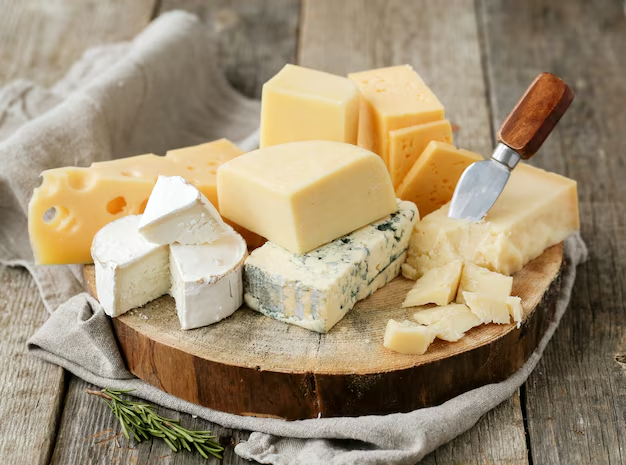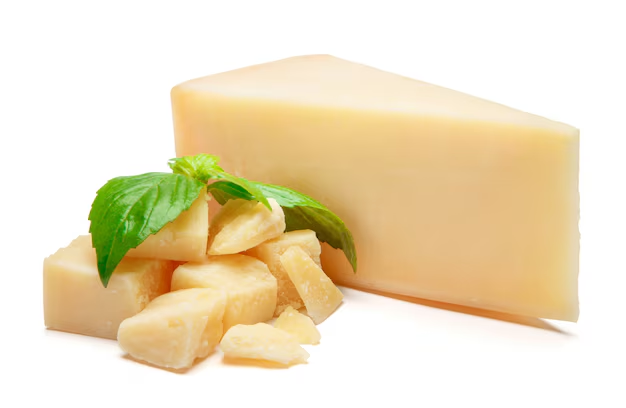Cheese is a beloved food enjoyed worldwide, but many wonder about its carbohydrate content. Does cheese have carbs? This question is especially important for those following low-carb or ketogenic diets. Cheese, derived from milk, is nutrient-dense and versatile. However, its carb count varies depending on the type.
This article explores the nutritional composition of cheese, focusing on its carbohydrates and how they differ among various varieties. Let’s dive into the details.
Nutritional Composition of Cheese
Cheese is packed with nutrients, making it a great addition to many diets. Its macronutrient profile primarily includes protein, fat, and a small amount of carbohydrates. While these nutrients vary across different types of cheese, they generally provide essential energy and support overall health.
Macronutrients in Cheese
The macronutrients in cheese include protein, fat, and carbohydrates. Each plays a unique role in nutrition.
Protein Content
Cheese is a rich source of high-quality protein. It provides essential amino acids that help build and repair tissues. The protein content in cheese varies, but harder cheeses like Parmesan often have higher protein levels compared to soft cheeses.
Fat Content
Cheese is also high in fat, with saturated fat being the most common type. This gives cheese its creamy texture and rich flavor. Fat content ranges from low-fat options to full-fat varieties, providing energy and helping the body absorb fat-soluble vitamins.
Carbohydrate Content
Cheese is naturally low in carbohydrates. Most of the carbs in cheese come from lactose, a natural sugar in milk. The fermentation process during cheese-making reduces lactose levels, especially in aged cheeses. This makes many cheeses suitable for low-carb diets.
To Read: Is Cheese Bad for Cholesterol? A Detailed Guide to the Facts
Does Cheese Contain Sugar?
Yes, but only in small amounts. The sugar in cheese comes from residual lactose. Aged cheeses, such as Parmesan or cheddar, have minimal to no lactose, making them nearly sugar-free. Softer cheeses like ricotta or cream cheese may contain slightly higher amounts of natural sugar.
Why Is Cheese a Popular Low-Carb Option?
Cheese is a favorite for low-carb and keto diets due to its minimal carb content and high-fat profile. It is also satisfying and versatile, fitting into various meals and recipes. From hard cheeses to soft spreads, there’s a low-carb cheese option for almost everyone.
Carbs in Different Types of Cheese
Not all cheeses are created equal when it comes to carbs. The carbohydrate content depends on the type and preparation of the cheese. Let’s explore this further.

Hard Cheeses
Hard cheeses are typically aged, which reduces their carbohydrate content. They are an excellent choice for low-carb diets.
Carbs in Cheddar Cheese
Cheddar cheese is a popular hard cheese with about 0.4 grams of carbs per ounce. Its long aging process breaks down lactose, making it nearly carb-free.
Carbs in Parmesan Cheese
Parmesan cheese, another aged variety, contains even fewer carbs—approximately 0.9 grams per ounce. Its intense flavor means a small amount goes a long way.
Soft Cheeses
Soft cheeses are creamy and spreadable, often containing slightly more carbs than hard cheeses.
Carbs in Cream Cheese
Cream cheese contains about 1 gram of carbs per ounce. It’s a favorite in keto recipes due to its low carb count and rich texture.
Carbs in Brie
Brie is a soft, creamy cheese with only 0.1 grams of carbs per ounce. Its low-carb nature makes it perfect for pairing with nuts or low-carb crackers.
Fresh Cheeses
Fresh cheeses are less processed and typically have a mild flavor. They may have a slightly higher carb content than aged cheeses.
Carbs in Mozzarella Cheese
Mozzarella cheese contains around 1 gram of carbs per ounce. It’s a staple in Italian dishes and works well in salads and low-carb pizzas.
Carbs in Ricotta Cheese
Ricotta cheese is slightly higher in carbs, with about 3 grams per half-cup serving. It’s often used in desserts and pasta dishes, so portion control is key.
Flavored and Processed Cheeses
Flavored and processed cheeses often contain added ingredients, which can increase their carb content.
Carbs in Cheese Spreads
Cheese spreads typically contain 2–3 grams of carbs per ounce due to added thickeners or flavoring agents. Check labels carefully if you’re watching your carb intake.
Carbs in Flavored Cheese Slices
Flavored cheese slices may have higher carb counts, ranging from 1–4 grams per slice. Additives like spices, herbs, or even sweeteners can contribute to the carb content.
What Makes Cheese Suitable for Keto Diets?
Cheese is a keto-friendly food thanks to its low carbohydrate and high-fat content. The ketogenic diet emphasizes minimal carbs and moderate protein, which fits perfectly with most types of cheese. Additionally, cheese provides essential nutrients like calcium and vitamin D, supporting overall health while keeping you in ketosis.
Best Low-Carb Cheeses for Keto Diets
Not all cheeses are equal when it comes to carb content. Some varieties are especially suitable for the keto lifestyle.
Hard Cheeses
Hard cheeses like Parmesan, cheddar, and Gouda are aged, which reduces their lactose (and carb) levels. These cheeses often contain less than 1 gram of carbs per ounce, making them a keto favorite.
Creamy Cheeses
Creamy cheeses, including cream cheese, mascarpone, and Brie, are rich and indulgent with minimal carbs. For example, cream cheese has about 1 gram of carbs per ounce, while Brie contains nearly zero carbs.
How to Incorporate Cheese Into a Keto Meal Plan?

Cheese is versatile, making it easy to add to any keto meal plan. Use shredded cheese as a topping for casseroles or keto pizzas. Pair creamy cheeses with low-carb vegetables like celery or cucumber for snacks. For breakfast, try scrambled eggs with grated cheddar. The possibilities are endless!
How Many Carbs Are in Cheese?
The carb content in cheese varies significantly by type. Hard cheeses like Parmesan and cheddar have less than 1 gram of carbs per ounce. Softer cheeses like ricotta may have up to 3 grams of carbs per serving. Flavored or processed cheeses can contain higher amounts.
Comparison of Carbs in Popular Cheeses
Let’s compare popular cheeses.
Cheddar vs. Mozzarella
Cheddar has approximately 0.4 grams of carbs per ounce, while mozzarella contains about 1 gram. Both are excellent options for low-carb diets, but cheddar edges out mozzarella for the lowest carb count.
Cream Cheese vs. Cottage Cheese
Cream cheese contains about 1 gram of carbs per ounce, making it a keto staple. Cottage cheese, on the other hand, has around 3-4 grams of carbs per half-cup, so it’s better suited for moderate low-carb diets.
Can Cheese Be Part of a Low-Carb Diet?
Cheese offers numerous benefits for those on a low-carb diet. It is nutrient-rich, providing protein, calcium, and healthy fats. It’s also highly satisfying, helping to curb cravings and keep hunger at bay. Plus, its versatility makes it a meal-prep superstar.
Common Misconceptions About Cheese and Carbs
Many people think all cheese is high in carbs due to its milk origin. However, the cheese-making process reduces lactose, leaving most cheeses with minimal carbs. Another misconception is that processed cheese is carb-free; it often contains additives that increase the carb count.
Tips for Choosing Low-Carb Cheeses
- Opt for aged or hard cheeses like cheddar or Gouda for the lowest carbs.
- Avoid processed or flavored varieties with hidden sugars.
- Check nutrition labels for accurate carb counts.
- Choose full-fat options to maximize flavor and keep you satiated.
FAQs
Is Cheese High in Carbs?
No, cheese is generally low in carbs. Most hard and aged cheeses contain less than 1 gram of carbs per ounce.
Can I Eat Cheese on Keto?
Yes, cheese is a keto-friendly food. Its low-carb and high-fat profile makes it ideal for maintaining ketosis.
Does Cheese Raise Blood Sugar Levels?
No, cheese has a minimal impact on blood sugar levels due to its low carbohydrate content.
What Cheese Is Best for Low-Carb Diets?
Hard cheeses like Parmesan and creamy options like Brie are excellent low-carb choices, each containing less than 1 gram of carbs per ounce.
Are Processed Cheeses Higher in Carbs?
Yes, processed cheeses often contain added ingredients like starches and sugars, which can increase their carb content.
Conclusion
Cheese is an excellent choice for both keto and low-carb diets. Its low carb content, high fat, and rich flavor make it a versatile ingredient. From hard cheeses like Parmesan to creamy ones like Brie, there’s a low-carb cheese for every palate. Understanding the differences in carb content among cheese varieties helps you make smarter dietary choices. Whether you’re snacking or cooking, cheese can be a delightful and nutritious part of your low-carb journey.

